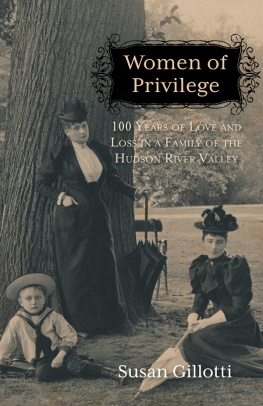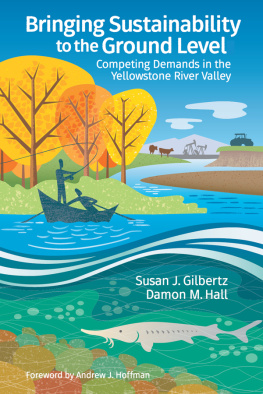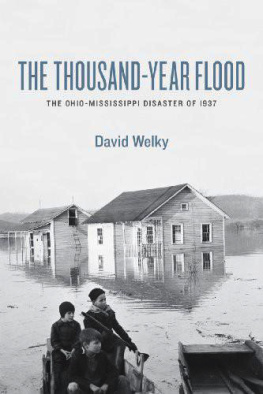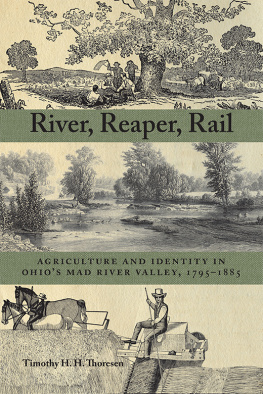Susan Sleeper-Smith - Indigenous Prosperity and American Conquest: Indian Women of the Ohio River Valley, 1690-1792
Here you can read online Susan Sleeper-Smith - Indigenous Prosperity and American Conquest: Indian Women of the Ohio River Valley, 1690-1792 full text of the book (entire story) in english for free. Download pdf and epub, get meaning, cover and reviews about this ebook. year: 2018, publisher: Omohundro Institute and University of North Carolina Press, genre: History. Description of the work, (preface) as well as reviews are available. Best literature library LitArk.com created for fans of good reading and offers a wide selection of genres:
Romance novel
Science fiction
Adventure
Detective
Science
History
Home and family
Prose
Art
Politics
Computer
Non-fiction
Religion
Business
Children
Humor
Choose a favorite category and find really read worthwhile books. Enjoy immersion in the world of imagination, feel the emotions of the characters or learn something new for yourself, make an fascinating discovery.

- Book:Indigenous Prosperity and American Conquest: Indian Women of the Ohio River Valley, 1690-1792
- Author:
- Publisher:Omohundro Institute and University of North Carolina Press
- Genre:
- Year:2018
- Rating:3 / 5
- Favourites:Add to favourites
- Your mark:
- 60
- 1
- 2
- 3
- 4
- 5
Indigenous Prosperity and American Conquest: Indian Women of the Ohio River Valley, 1690-1792: summary, description and annotation
We offer to read an annotation, description, summary or preface (depends on what the author of the book "Indigenous Prosperity and American Conquest: Indian Women of the Ohio River Valley, 1690-1792" wrote himself). If you haven't found the necessary information about the book — write in the comments, we will try to find it.
Indigenous Prosperity and American Conquest: Indian Women of the Ohio River Valley, 1690-1792 — read online for free the complete book (whole text) full work
Below is the text of the book, divided by pages. System saving the place of the last page read, allows you to conveniently read the book "Indigenous Prosperity and American Conquest: Indian Women of the Ohio River Valley, 1690-1792" online for free, without having to search again every time where you left off. Put a bookmark, and you can go to the page where you finished reading at any time.
Font size:
Interval:
Bookmark:

INDIGENOUS PROSPERITY AND AMERICAN CONQUEST
The Omohundro Institute of Early American History and Culture is sponsored by the College of William and Mary. On November 15, 1996, the Institute adopted the present name in honor of a bequest from Malvern H. Omohundro, Jr.
2018 The Omohundro Institute of Early American History and Culture
All rights reserved
Manufactured in the United States of America
Table 1 previously appeared in Susan Sleeper-Smith, Indian Women and French Men: Rethinking Cultural Encounter in the Western Great Lakes (Amherst, Mass., 2001), 126.
Jacket illustration: Watercolor by George Winter, courtesy of Tippecanoe County Historical Association, Lafayette, IN
Library of Congress Cataloging-in-Publication Data
Names: Sleeper-Smith, Susan, author.
Title: Indigenous prosperity and American conquest : Indian women of the Ohio River Valley, 16901792 / Susan Sleeper-Smith.
Description: Williamsburg, Virginia : Omohundro Institute of Early American History and Culture ; Chapel Hill : University of North Carolina Press, [2018] | Includes bibliographical references and index.
Identifiers: LCCN 2017059439 | ISBN 9781469640587 (cloth : alk. paper) | ISBN 9781469640594 (ebook)
Subjects: LCSH : Indians of North AmericaOhio River ValleyGovernment relations. | Indians, Treatment ofOhio River ValleyHistory. | Indian women Ohio River ValleyHistory18th century. | Indian womenOhio River ValleyHistory17th century. | KidnappingOhio River ValleyHistory. | United StatesHistory17831815. | United StatesHistory17831865.
Classification: LCC E78.O4 S58 2018 | DDC 977.004/97dc23 LC record available at https://lccn.loc.gov/2017059439
The University of North Carolina Press has been a member of the Green Press Initiative since 2003.
To the women who raised me:
My grandmother, Hansine
My mother, Nellie
My sisters, Dorothy and Helene
When I began research on my first book, I happened onto a little-known archive in West Lafayette, Indiana: the Tippecanoe County Historical Society. Housed there is a remarkable body of work by an English artist who arrived in Logansport, Indiana, in the 1830s. His interest in Indian people led him to portray many Miami and Potawatomi people who lived in nearby villages along the Wabash River. His sketches and paintings reveal a prosperous world where Indian people wore colorful calicoes, fine-woven woolens, and elegant silks, their clothing and bodies richly ornamented with trade silver. I remember briefly discussing George Winters portraits at my first job interview; most scholars were surprised by Indian dress and questioned his depictions of Indian houses. Several scholars insisted that this was ceremonial dress, certainly not daily dress. Many historians still resist the notion of prosperous Indian communities in the Ohio River valley. Most scholarly literature remains embedded in the vision of a region peopled with colonist settlers whose hardy natures, perseverance, and farming skills rapidly replaced nomadic Indians. It is my hope that this volume will bring greater attention to a region that has been long neglected and shifts our focus to the Indians who first settled and farmed the Ohio River valley.
I have accumulated many scholarly debts in writing Indigenous Prosperity and American Conquests, and I am grateful to everyone who contributed time to reading and commenting on papers at seminars and workshops where I presented much of this material. Their invaluable observations have shaped this book and provided crucial feedback. Those errors that remain are entirely my fault. I know there are people that I will forget to mention, and I hope they forgive me.
I owe a debt of gratitude to Dan Usner and the late Drew Cayton for reading several versions of this manuscript. Their insightful commentary, careful reviews, and excellent suggestions transformed my extensive research into a comprehensive and coherent manuscript. I owe an even greater thank-you to the diligent and careful review of every statement and word in this manuscript by Paul Mapp and M. Kathryn Burdette. I could not have asked for more generous and rigorous editors. Their dedicated reading helped sharpen the focus of this manuscript. The Omohundro workshop on Early American Women provided a forum for my research, and Karin Wulf encouraged me to publish with the Institute. She has provided the opportunity to work with truly gifted editors, and the instances of elegant prose in this manuscript reflects Paul and Kathryns meticulous and thoughtful editing. The long process of helping to make this monograph reality also owes a great deal to my department chairman, Walter Hawthorne. He has been an inspiration and a much needed ally. Walter expends incredible effort in locating the funds and creating the circumstances that make it possible for our faculty to be productive scholars. His enthusiasm and support have made it a real pleasure to work at Michigan State University.
My work owes a great deal to the Newberry Library, which has been my primary research home. President David Spadafora has fostered a congenial scholarly atmosphere; he sets the tone for his staff and contributes to many scholarly seminars. I am thankful for the privilege of working with Danny Greene, formerly the Vice-President for Research, whose insight and diligence transformed the Fellows Seminars into a crucial discussion forum. Brad Hunt has both advanced the Newberrys intellectual life and enthusiastically supported my research. No one could ask for a more supportive staff than the directors of the DArcy McNickle Center, Scott Manning Stevens and Patricia Marroquin Norby. The working seminars in Indian Studies, Women and Gender History, and the Fellows Seminars have transformed the direction of my research. A special thank-you to the many scholars who have read and commented on my work: Leon Fink, Roy Fogelson, Brenda Child, Jeani OBrien, Jeff Ostler, Cary Miller, Ella Tandy Shermer, Barbara Hanawalt, Cathleen Cahill, Kathleen Washburn, Juliana Barr, Colin Calloway, Frances Hagemann, Christopher McKee, Peter Nekola, Elliott Gorn, Liesl Olson, Margaret Newell, Toby Higbie, Mary Bane Campbell, Christina Stanciu, Margaret Meserve, Michael Schreffler, Phil Round, Jacob Lee, Lisa Freeman, Stephen Foster, and Rowena McClinton. The Newberry has a vast range of supportive staff, and both John Powell and Catherine Gass have patiently guided me through the ins and outs of the Newberrys rich collection of archival images.
I have had the good fortune of being generously supported by an NEH grant from the Newberry Library, by the Filson Historical Society, and by the Michigan State University College of Social Science. Glenn Crothers and the staff of the Filson provided invaluable direction in navigating the archives. There are many smaller archives with very limited personnel that have been tremendously supportive: the Tippecanoe Historical Society, the Porter County Historical Society, the Michigan State Archives, and the Northern Indiana Historical Society. The Indiana Historical Society, Burton Historical Collections in Detroit, the Wisconsin Historical Society, Minnesota Historical Society, the Chicago Historical Society, Special Collections at the University of Kentucky, the Missouri Historical Collections, Historic New Orleans Collection, Library and Archives Canada in Ottawa, and the British Library have been crucial to my research. A very special thank-you to Special Collections at Michigan State University. I am always thankful when I have the opportunity to work with Peter I. Berg, who is our head of Special Collections. He has transformed a once small collection into an outstanding resource for scholars of early history, creating a strong collection that has drawn people to the library. In
Font size:
Interval:
Bookmark:
Similar books «Indigenous Prosperity and American Conquest: Indian Women of the Ohio River Valley, 1690-1792»
Look at similar books to Indigenous Prosperity and American Conquest: Indian Women of the Ohio River Valley, 1690-1792. We have selected literature similar in name and meaning in the hope of providing readers with more options to find new, interesting, not yet read works.
Discussion, reviews of the book Indigenous Prosperity and American Conquest: Indian Women of the Ohio River Valley, 1690-1792 and just readers' own opinions. Leave your comments, write what you think about the work, its meaning or the main characters. Specify what exactly you liked and what you didn't like, and why you think so.






